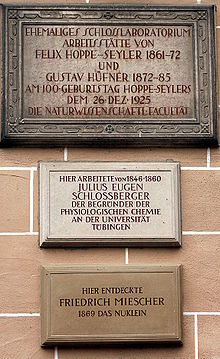Julius Eugen Schloßberger
Julius Eugen Schloßberger (born May 31, 1819 in Stuttgart , † July 9, 1860 in Tübingen ) was a German biochemist and doctor.
biography
Schloßberger first studied medicine in Tübingen and wrote a thesis on the muscles of various animals as a student. At the age of 21 he becomes Dr. med. et chir. doctorate, subsequently worked from 1841 to 1842 as an assistant doctor at the Katharinenhospital Stuttgart and as a personal physician to a count. In Stuttgart, medical articles were written on the urinary gravel and the urinary system of newborns. Further studies in Vienna , Paris and Giessen followed, whereby the influence of Justus von Liebig induced him to turn to physiological chemistry. In Giessen, Schloßberger u. a. the fat balance of the animals and the composition of rhubarb and its healing powers.
In 1845 Schloßberger became an assistant at Gregory's chemical laboratory in Edinburgh. Here he is mainly active in nutritional science (importance of nitrogen in food). Stays at the Universities of Utrecht and Berlin followed before he went to Tübingen as a professor of physiological chemistry. In addition to teaching, he studies substitutes for cereal flour and writes a "textbook on organic chemistry" (Stuttgart 1850). A large number of works in different areas originate from him: analyzes and summaries of physiological sub-areas, chemical composition of body tissues such as muscles ( creatine ), brain tissue, breast milk; Respiratory physiology, food chemistry, pathobiochemical studies, and also purely chemical analyzes.
He was a member of the Society of German Natural Scientists and Doctors . In 1857 he was elected a member of the German Academy of Sciences Leopoldina .
In 2015, the museum room "Castle Laboratory Tübingen: Cradle of Biochemistry" was set up in the premises of the former kitchen of Hohentübingen Castle by the Museum of the University of Tübingen MUT . His main theme is the establishment of one of the world's first (1818) biochemical laboratories at this location.
Fonts
- Textbook of organic chemistry with special regard to physiology and pathology, pharmacy, technology and agriculture , Verlag JB Müller, Stuttgart 1850 BSB digital
literature
- Bernhard Lepsius : Schloßberger, Julius Eugen . In: Allgemeine Deutsche Biographie (ADB). Volume 31, Duncker & Humblot, Leipzig 1890, pp. 531-533.
- Gerhard Müller-Strahl: Schlossberger, Julius Eugen. In: New German Biography (NDB). Volume 23, Duncker & Humblot, Berlin 2007, ISBN 978-3-428-11204-3 , p. 100 f. ( Digitized version ).
Individual evidence
- ↑ Members of the Society of German Natural Scientists and Doctors 1857
- ↑ Member entry of Julius Eugen Schlossberger at the German Academy of Natural Scientists Leopoldina , accessed on June 21, 2016.
| personal data | |
|---|---|
| SURNAME | Schlossberger, Julius Eugen |
| BRIEF DESCRIPTION | German biochemist and doctor |
| DATE OF BIRTH | May 31, 1819 |
| PLACE OF BIRTH | Stuttgart |
| DATE OF DEATH | July 9, 1860 |
| Place of death | Tübingen |
